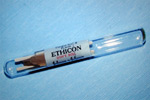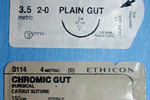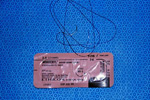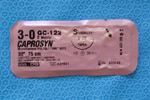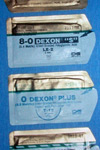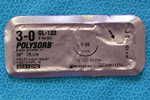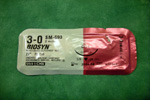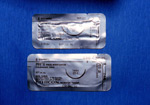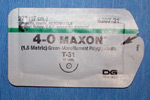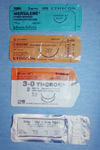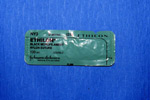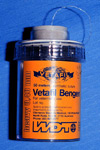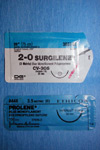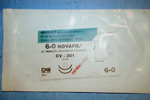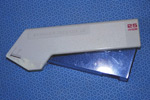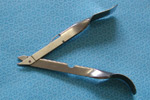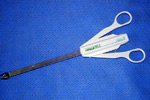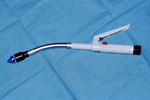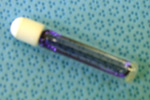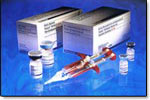Equipment / Instruments
Unit 11: Sutures & Other Materials
Topic 1: Suture Types
1.1 Classification of sutures
Absorbable vs Non-absorbable.
Absorbable sutures usually are those which undergo rapid degradation and loss of tensile strength within 60 days of implantation, whilst non-absorbable sutures retain significant strength past 60 days.
Monofilament vs Multifilament construction.
Monofilament sutures have a number of significant advantages over the multifilaments in that they produce less tissue drag when being passed through tissues, they generally cause less tissue reaction, and have reduced capillarity than the multifilament materials. Most multifilament materials are now coated with various substances in an attempt to overcome these disadvantages. The multifilament sutures however tend to be easier to handle, have less memory than the monofilaments and have better knot security.
Origin.
Catgut, linen and silk are "natural" materials whilst all other available sutures are considered to be of "synthetic" origin.
1.2 Available suture types
- Absorbable Materials
- Rapidly absorbable materials
- Medium-term absorbable materials
- Longer-term absorbable materials
- Non-Absorbable Materials
- Tissue Adhesives
Absorbable Materials
There are a large number of absorbable suture materials now on the market. They will be described under the headings of rapid, medium and longer-term absorbable materials. This is however a loose descriptor as the rate of absorption depends on large number of factors (see later), but will be used for the sake of simplicity, and as an aid to suture selection.
- Rapidly absorbable materials
- Catgut
- Monocryl
- Vicryl Rapide
- Caprosyn
- Medium-term absorbable materials
- Dexon
- Vicryl
- Polysorb
- Biosyn
- Longer-term absorbable materials
- PDS
- Maxon
Absorbable Materials - rapidly absorbable
Catgut
Catgut is an absorbable natural material that has been commercially available longer than any other material and is available in plain and chromic forms.
It remains the most commonly used suture material in veterinary practice. Catgut is made from intestinal submucosa of sheep and intestinal serosa of cattle and is processed with formaldehyde and spun to produce a tightly twisted thread.
Plain catgut incites a marked inflammatory response within the body. It is removed from the body by phagocytosis and enzymatic degradation. It looses all effective strength within 15 days of implantation.
Chromic catgut results in less of an inflammatory reaction because it is exposed to chromium salts which results in additional cross-links and durability. The tissue reaction is less, although still quite marked relative to the synthetic absorbable materials, and all effective strength is lost within 30 days.
Catgut has good handling characteristics, although the knots may loosen when wet due to swelling of the fibres.
The main advantage of catgut is its relatively low cost.
Monocryl (Polyglecaprone 25: Ethicon)
Monocryl (Polyglecaprone 25: Ethicon) is a synthetic absorbable monofilament suture derived from a copolymer of glycolide and epsilon-caprolactone. It produces only a mild inflammatory response and while being initially quite strong it loses tensile strength very rapidly (40% in 7 days and 80% in 12 days) and retains no effective strength after three weeks, i.e. similar to catgut. It has little memory and is extremely easy to use and has good knot security. Its greatest use is for gastrointestinal, urinary and reproductive tract surgery. Because of its rapid loss of tensile strength, however, it is contraindicated for closure of slower healing tissues such as the abdominal wall, and vascular and ophthalmological uses.
Vicryl Rapide (Ethicon)
Vicryl Rapide is an ultra-rapidly absorbing suture material which is useful in tissues that heal rapidly, and has been used successfully in avian surgery.
It has approximately 60% of the initial strength of standard Vicryl (see below), and losses 50% of its strength in 5 days, and 100% of its tensile strength in 10-14 days.
Caprosyn (Polyglytone – USS-DG)
Caprosyn is a monofilament rapidly absorbing suture material which has a similar initial tensile strength to Monocryl, but then is absorbed more rapidly.
Absorbable Materials - medium term absorbable
Dexon (Polyglycolic acid: Davis & Geck)
Dexon is an absorbable braided multifilament synthetic polymer of glycolide monomers. It was first described in 1970. It was initially available as an uncoated material that caused considerable tissue drag during placement. Dexon S was then introduced to allow smoother suture placement by silicone treatment of the fibrils, and later coated Dexon Plus was introduced. Polyglycolic acid is absorbed by hydrolysis and the hydrolysis products are reported to be bacteriostatic. Knot security, however, is relatively low, especially in the coated forms.
Dexon II is now available which has improved handling characteristics due to a new smoother coating of polycaprolate and increased strength as a result of smaller but increased numbers of fibres within each strand. It losses 35% of its tensile strength in 14 days, and 65% in 21 days.
Vicryl (Polyglactin 910: Ethicon)
Vicryl (Polyglactin 910: Ethicon) was introduced into the market shortly after Dexon. It is also a braided multifilament synthetic absorbable copolymer containing 90% glycolide and 10% lactide. It is also coated to improve its handling properties, with a combination of calcium stearate and polyglactin 370. It is absorbed by hydrolysis at a similar rate to polyglycolic acid (35% in 14 days and 60% in 21 days).
Polysorb (Braided Lactomer: USS-DG)
This material has similar physical and tensile properties to Vicryl, except that it is slightly stronger initially.
Biosyn (Monofilament Glycomer: USS-DG)
Bosyn is a monofilament material with high initial tensile strength which is then lost at a similar rate to Vicryl.
Absorbable Materials - longer term absorbable
PDS (Polydioxanone: Ethicon)
PDS (Polydioxanone: Ethicon) is a synthetic monofilament material that was first reported in 1981. Similar to the other synthetic absorbables it is absorbed by hydrolysis, but at a much slower rate, with tensile strength being maintained for nearly twice as long, although finer sutures are hydrolysed relatively more quickly (50% loss of tensile strength in 28 days and 75% in 75 days).
Unlike Dexon and Vicryl, which are too stiff to be used as a monofilament, PDS is a flexible monofilament. It is very strong but it does maintain a degree of memory, so requires care when tying knots. The degree of memory and its propensity to kink and pig-tail, especially when used as a continuous suture, can be a problem. PDS II was released in 1990 and overcomes some of this trend, which has also been reduced somewhat by the introduction of new ‘relay packaging’.
Maxon
Maxon (Polyglyconate: Davis & Geck) is a monofilament absorbable material made from a copolymer of glycolic acid and trimethylcarbonate. It has similar properties and is hydrolysed at a similar rate to polydioxanone (Loss of 50% tensile strength in 28 days and 75% in 42 days).
Maxon is also available as a looped suture for the closure of abdominal wounds. It eliminates the initial knot at the start of the incision and allows the placement of an exceptionally strong double-strand continuous closure.
Non-Absorbable Material
Silk
Natural braided non-absorbable material that results in a marked tissue reaction. It is one of the first materials used as a suture. It has very high capillarity which is reduced by coating it with wax in some forms. It is now used primarily for ligating large blood vessels.
Linen
Braided material which is spun from flax fibres and causes significant tissue reaction. It is used almost exclusively in gastrointestinal surgery.
Polyester
(Mersilene: Ethicon, Miralene: Davis & Geck; Polydek: Surgicraft; Dacron: Davis and Geck) is a multifilament braided that which is extremely strong, durable, pliable and easy to handle. It causes a tissue reaction similar in extent to catgut. Polyester is also available in a coated forms to allow smooth suturing (Tevdek: coated in Teflon, Ticron: Davis & Geck, coated with silicone, Ethibond: Ethicon, coated with polybutylate).
Polyamides
Used as suture materials include nylon and polymerised caprolactum.
Nylon is available as a monofilament (Ethilon: Ethicon, Dermalon: Davis & Geck) or a multifilament material (Surgilon: Davis & Geck, Nurolon: Ethicon). It is essentially non-absorbable, but will hydrolyse slowly releasing bacteriostatic polyamide radicals. In the monofilament form it possesses significant memory which makes placing sutures and tying knot difficult.
Caprolactum (Vetafil, Supramid, Braunamid) is a twisted multifilament coated material which has good handling characteristics. The proteinaceous coating, however, fractures easily, increasing its capillarity. It should be used only in the skin and causes moderate tissue reaction.
Polyolefins include polypropylene, polyethylene and polytetrafluoroethylene.
Polypropylene (Prolene: Ethicon, Surgilene: Davis & Geck) is a polymerised polyolefin. It is a strong monofilamentous non-absorbable suture material that causes minimal tissue reaction. It is also relatively haemocompatible and is used extensively in vascular surgery. It does possess some memory and care needs to be exercised when tying knots.
Polybutester (Novafil: Davis & Geck) is a non-absorbable monofilament copolymer of polybutylene. It is a relatively soft supple material and not as stiff as Nylon. It is also quite elastic. It has little packet memory and good knot security.
Stainless Steel
Stainless steel is available as a monofilament or multifilament suture material. It has the highest tensile strength and greatest knot security of all the materials. It is essentially inert but has poor durability to repeated flexing and may break.
Staples
Staples are also available for a number of uses. They are very useful in closing skin wounds and the linea alba in which the healing that results from their use is as good as sutures.
They are relatively expensive and need a special instrument to remove the staples from the skin, but the operative time saved may compensate for the additional expense.
Other areas in which stainless steel is useful is in the use of clips to ligate blood vessels.
A number of sophisticated stapling instruments such as linear staplers, linear cutters and intraluminal staplers are available for gastrointestinal and thoracic surgery.
Most of the staplers are now fully disposable, although some have replacement staple cartridges.
Tissue Adhesives
Tissue Adhesives have yet to receive wide-spread acceptance as a substitute to sutures.
Various cyanoacrylates have been used as tissue adhesives, although they have been associated with tissue toxicity and delayed wound healing. They polymerise in the moisture present in a wound with the release of heat. The n-butyl and isobutyl-2-cyanoacrylates have been marketed for veterinary use.
Fibrin sealants and glues [eg. Tiseel VH (Baxter Healthcare Corp, Deerfield IL, USA), Quixil (Omrix, Brussels, Belgium)] have also been used as a tissue adhesives to aid haemostasis, wound healing, tissue adhesion and drug delivery.
These products contain fibrinogen, thrombin and activated factor XIII, which when mixed produce fibrin. Unit 6 Haemostasis
